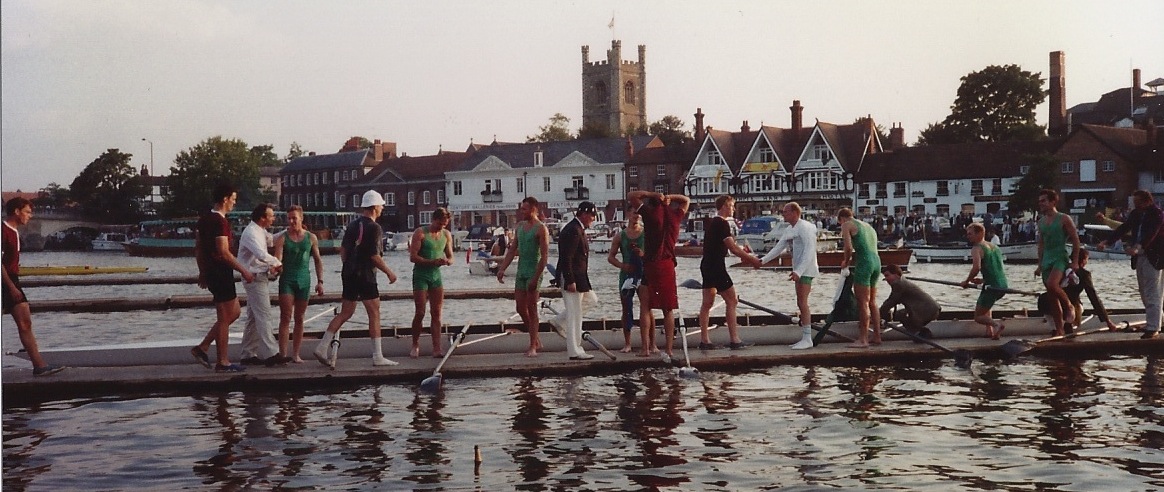The Royal National Lifeboat Institution was the official charity partner for the 2022 Boat Race. The Chiswick Lifeboat station, one of the busiest in the country, stands on Middlesex bank of the Boat Race course – between Hammersmith and Barnes bridges. However, connections between the two institutions go back more than 150 years. One less well known connection is the lifeboat that never was.
Both the RNLI and the Boat Race were important to John Graham Chambers, a rowing double-blue who competed for Cambridge in the 1862 and ’63 races. He was elected president of CUBC in 1865 and remained part of the Cambridge coaching set-up through most of the 1870s. As a serial lawmaker in various sports, Chambers was also the principal author of the Queensberry Rules for boxing.
On leaving Cambridge in 1865 Chambers moved to London and entered the world of “literature” as a contributor to the Standard and Land and Water newspapers. To continue rowing, he joined Leander Club whose members were then predominantly Oxbridge alumni. The club had relocated from Stangate, opposite the Houses of Parliament, to the Putney Embankment in 1860.
From 1871 until his death, Chambers was editor of Land and Water. Under his editorship, this “first class weekly journal of hunting, shooting, athletics, aquatics, practical natural history, sea & river fisheries, &c” regularly reported on the achievements of the RNLI. The paper also championed the life-saving importance of the ability to swim.
Even by Victorian standards, Chambers’ death on Sunday 4 March 1883 – three weeks after his 40th birthday – was premature. By coincidence, Chambers died on the anniversary of the founding of the RNLI in 1824.
Land and Water of Saturday 17 March 1883 contains a report of Leander’s AGM which had taken place at the Criterium the previous Monday, 12 March. William Wightman Wood, who had known Chambers at Eton and rowed in the Oxford crews of 1866 and ‘67, spoke of “the heavy loss that both the club and the wider athletic world had suffered”.
Arthur William Nicholson, a three-times Oxford blue between 1872 and ‘74 and OUBC president in 1873, announced a proposal to raise funds for a memorial lifeboat to be called John Chambers.
John Goldie, Leander’s treasurer at the time, said (in typically flowery Victorian prose):
“It is with great pleasure that I learnt this evening that a suggestion has been made, that all who knew him and valued him as we do should unite and in some way perpetuate his memory. The form that has been suggested, viz., that of a lifeboat, is, I venture to think, singularly appropriate, not only from its actual connection with the sport he so excelled in, but because the unselfish devotion which marks the lifeboat service matches so well with the life and character of him we all knew so well as John Chambers.”
Land and Water, Saturday 17 March 1883
Goldie was a four-times light blue and CUBC president for three years. He had ended a nine race losing streak by stroking Cambridge to victory in 1870. The Cambridge reserve crew and CUBC boathouse are named in his honour.
However, an enquiry to the RNLI archive revealed there is no record of a lifeboat called John Chambers. So what happened to the fund-raising?
Nicholson may have become distracted by his impending nuptials. He married a Miss Astley of Arisaig just seven weeks after the AGM on Monday 7 May 1883. Miss Astley was clearly a woman of some means – nearly 700 tenants from her Scottish estates subscribed to buy a wedding present and joined the festivities when the newly-weds arrived in Arisaig on honeymoon.
It would appear the proposed appeal was not a Leander initiative. There is no mention of the appeal in Leander’s surviving records. In his remarks, Wood included the caveat that, “No definite step in the matter had yet been taken,” but he felt sure that rowing men such as the Leander members would want to contribute.
Perhaps the intention was that the wider athletic world would want to contribute. Chambers had been involved in establishing the ‘varsity athletics match in 1864 and the Amateur Athletic Club in December 1865. Conceived as the equivalent of the Jockey Club or the MCC for athletic sports, the AAC, which was also dominated by Oxbridge alumni, staged what were effectively the first national championships for athletics in 1866; the first boxing matches under the Queensberry Rules and a swimming championships (in the Thames at Teddington) in 1867; and track-cycling races in 1871.
The initiative appears to have lacked an organiser. Chambers himself had experience of raising a public subscription. In 1875 he co-organised a testimonial for Captain Matthew Webb in recognition of his pioneering cross-channel swim.
Arthur Gay Payne, sports editor of the Standard and Chambers’ deputy at Land and Water had organised the logistics for Webb’s attempt. In the small world of Victorian sports journalism, Payne was a contemporary of Chambers at Cambridge, where he had coxed the Peterhouse eight. Payne would later co-author Webb’s memoir, the Art of Swimming. During the cross-channel attempt, Chambers had rowed himself out to meet up with the support boat and even swam alongside Webb for a while. Chambers then rowed back to Dover to telegraph Payne’s progress report back to Fleet Street to be included in the papers that appeared the following morning, Wednesday 25 August, before the exhausted Webb finally made landfall in France at 10:47 am.
Henry Chinnery, a member of the stock exchange, was named alongside Chambers as a subscription collector in ads that ran in Land and Water. Chinnery was a versatile athlete himself: he was a competitive quarter-miler and had won the middle-weight category in the first boxing championships fought under the Queensberry Rules organised by Chambers. Together, the pair raised £2,424 4s 11d [worth in excess of £156,000 today] for Webb. There is no trace of any small ads promoting a Chambers’ lifeboat appeal in any of the sporting papers.
Had the lifeboat John Chambers come to pass, it wouldn’t have been the first named after a journalistic rowing blue. Around 1859, CUBC started a subscription fund to raise £250 [£16,500] for a lifeboat to be named Tom Egan. At the time, Thomas Selby Egan was the aquatics editor of Bell’s Life. After 1868 he moved into the editor’s chair. Egan had coxed Cambridge in the Boat Races of 1836, ’39 and ’40, coached both universities during the 1850s and even managed to supervise both crews during their preparations for the 1856 race. He umpired the race four times. This fund reached its target in 1864. The following year, Tom Egan, “a powerful 32 feet life-boat” entered service at Tramore near Waterford, Ireland, replacing a smaller boat considered inadequate for the tricky local waters.
The 1883 Boat Race took place just eleven days after Chambers’ death. Unusually it was rowed late in the afternoon on a Thursday, 15 March. The Cambridge stroke failed to hear the command to start and the race finished in a “blinding snowstorm”. Oxford won by three and a half lengths. The University Boat Race Official Centenary History summed the race up as “a fiasco”.
In a coincidence of timing, the AGM of the RNLI took place on Tuesday 13 March 1883, at Willis’s Rooms, London. The annual report recorded that nine new lifeboats had been added to the fleet during the year, bringing the total to 273. The lifeboats saved 741 people and “rescued 23 vessels from destruction”. Donations, subscriptions and dividends received totaled £43,117 [approx. £2.85 million at today’s prices] against expenditure of £36,746 [£2.43 million].
The RNLI celebrates its bicentenary in on 4 March 2024 – the 141st anniversary of Chambers’ death. In 2022, the year the RNLI was the Boat Race’s official charity partner, 438 lifeboats were involved in 9,312 launches. Annual running costs reached £188 million.



